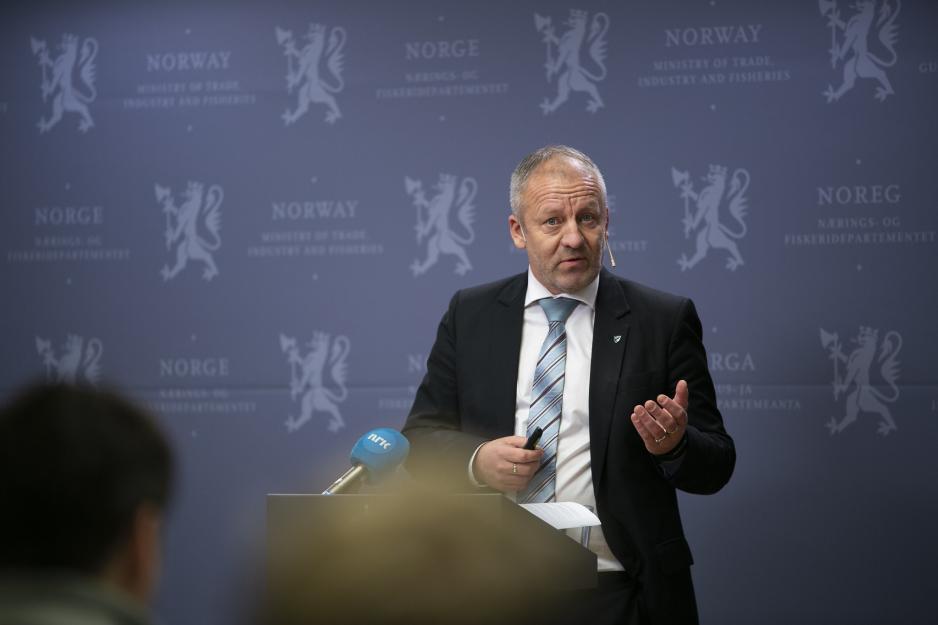They Receive Generous Severances, but Do They Realize What is Happening?

Cabinet members, here represented by Fisheries and Seafood Minister Geir Inge Sivertsen (Conservatives), receive generous severances from their former jobs. But do they also realize what is happening in Northern Norway? Photo: The Ministry of Trade, Industry and Fisheries
Erna Solberg’s cabinet members receive generous severances from former employers. But do they also realize what is happening in the High North? Could it be that some of them are too focused on increasing their own bank accounts instead of spending time on state finances?
I ask. Because how else is one to understand the breakdown in North Norwegian infrastructure, when seen in light of the visions about a booming industry and population growth?
The state’s task
Even Adam Smith, father of classical liberalism, maintained that society’s infrastructure is one of the state’s core tasks. There is hardly any disagreement in economic theory about the importance of facilitating transport of goods and people.
Yet the attacks go right to the core of this task.
First in the form of an out-of-this-world increase in sea-based commuter transportation. This is an extraordinarily efficient tool if what you want to achieve is worsened market access for North Norwegian business and industry. We are already on the back foot as whatever we produce has to travel far to find its buyers.
Then Widerøe hits the mark with its proposal about shutting down flight routes that tie the region together. These are commercial routes; i.e. routes that are not subsidized by the state, nor profitable – according to the airline.
Anyone who has watched the new Transport Minister, Knut Arild Hareide, run from TV studio to TV studio over the past few weeks has realized the gravity of the situation.
“We have to sit down at the table and talk about this” he repeats, wearing his most worried face.
We must talk about it
Because this is serious, and the minister gets it. He just does not have anything to offer but talk so far.
And yes, of course we can talk about the consequences of such drastic attempts at shooting down any vision about growth in the High North. But perhaps we should also talk about the understanding of politics that underpins the political choices that have left the region in this hopeless situation?
While we, the inhabitants, depend on organizing our lives as a whole in order to make ends meet in all areas, the state has organized itself into units that tear our lives up into minute pieces.
Is it really the case that when a fisheries minister, severance or no severance, returns to his government office following successful visits to companies along the coast, the job is done? Or should he place this recent experience into a wider context and set up a meeting with the Ministry of Transportation before the planes are permanently grounded and the ferries docked for good?
This is not an acquittal of Widerøe nor the transportation companies operating the ferries. This image is complicated. But that is exactly why we have chosen politicians who are to sort out solutions rather than leaving one of the pillars of society to its own perils and random chance.
System failure
What happens along the Norwegian coast today is a serious system failure. The fact is, whoever one is to blame, that the infrastructure breakdown is a serious violation of the contract between us as users and citizens, and the State, represented by politicians and bureaucrats.
On an overall level, infrastructure is about transporting goods, people and services to a market. and it is also about maintaining open channels between decision-makers and users. In theory, we could solve the latter by moving all of us to Oslo and then hop on a tram to speak reason with the Minister of Transport. That would be a complicated, but theoretically viable solution.
Worse, however, would be any attempt to relocate our spawning cod, the skrei, closer to the transport sector around the Oslo fjord. The windmills we are forced to accept may perhaps be put on the rooftop of the opera house; however, raw material based industries are not very mobile. Perhaps the fish farming nets with salmon may be placed on land at Youngstorget square, the center of the workers’ movement, and power cables from our pure energy could follow a one-way track to the south. Moving health services and preparedness efforts down south is also possible, given that we empty our region of the elderly and anyone who is ill.
But this takes time and is, of course, not a goal at all. On the contrary.
There are piles and piles of documents aiming to grow the economy in the High North. There are equally high piles of government documents emphasizing the importance of effective infrastructure.
Yet we arrive at solutions pointing in the exact opposite direction.
Understand that if you can.

